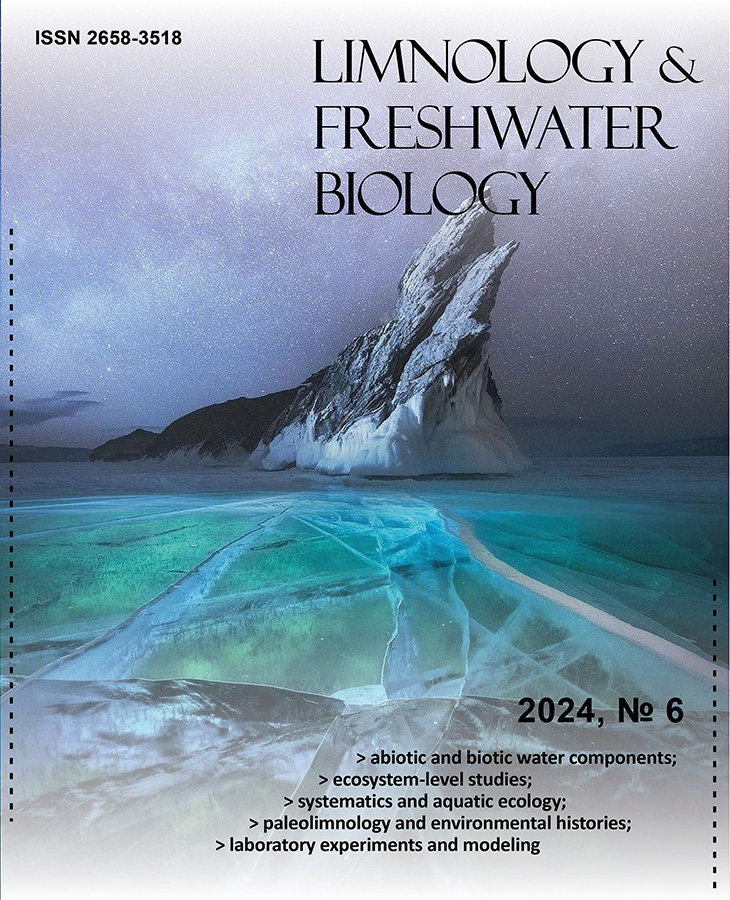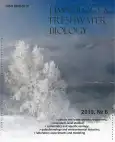Chemical composition and quality of water of the Selenga River and its tributaries in Mongolia
- Authors: Sorokovikova L.M.1, Tomberg I.V.1, Stepanova O.G.1, Marinaite I.I.1, Bashenkhaeva N.V.1, Khash-Erdene S.2, Fedotov A.P.1
-
Affiliations:
- Limnological Institute of the Siberian Branch of the Russian Academy of Sciences
- Mongolian Knowledge Society
- Issue: No 6 (2019)
- Pages: 332-338
- Section: Articles
- URL: https://journal-vniispk.ru/2658-3518/article/view/284727
- DOI: https://doi.org/10.31951/2658-3518-2019-A-6-332
- ID: 284727
Cite item
Full Text
Abstract
The chemical composition and current state of water quality of the Selenga River and its tributaries in Mongolia are considered in this article based on the hydrochemical studies carried out in July 2013-2014. The observed changes in the chemical composition of the water resulted from natural and anthropogenic factors are analyzed. It is shown that water quality of the Selenga River and its tributaries worsened because of the entering of polluting components from the catchment area of Ulaanbaatar city and its wastewater. No influence of the wastewater from the Erdenet Ore-Dressing Plant (EODP) on the trace elements content in the water of the Orkhon and Selenga Rivers is revealed.
About the authors
L. M. Sorokovikova
Limnological Institute of the Siberian Branch of the Russian Academy of Sciences
Email: kaktus@lin.irk.ru
Russian Federation, 3, Ulan-Batorskaya St., Irkutsk, 664033
I. V. Tomberg
Limnological Institute of the Siberian Branch of the Russian Academy of Sciences
Author for correspondence.
Email: kaktus@lin.irk.ru
Russian Federation, 3, Ulan-Batorskaya St., Irkutsk, 664033
O. G. Stepanova
Limnological Institute of the Siberian Branch of the Russian Academy of Sciences
Email: kaktus@lin.irk.ru
Russian Federation, 3, Ulan-Batorskaya St., Irkutsk, 664033
I. I. Marinaite
Limnological Institute of the Siberian Branch of the Russian Academy of Sciences
Email: kaktus@lin.irk.ru
Russian Federation, 3, Ulan-Batorskaya St., Irkutsk, 664033
N. V. Bashenkhaeva
Limnological Institute of the Siberian Branch of the Russian Academy of Sciences
Email: kaktus@lin.irk.ru
Russian Federation, 3, Ulan-Batorskaya St., Irkutsk, 664033
S. Khash-Erdene
Mongolian Knowledge Society
Email: kaktus@lin.irk.ru
Mongolia, Erdenet, 61000
A. P. Fedotov
Limnological Institute of the Siberian Branch of the Russian Academy of Sciences
Email: kaktus@lin.irk.ru
Russian Federation, 3, Ulan-Batorskaya St., Irkutsk, 664033
References
- Anikanova M.N., Batima P., Nyamzhav P. et al. 1991. O raschete stoka khimicheskikh veshchestv s vodami rek basseyna r. Selengi na territorii MNR. In: Izrael Yu.A., Anokhin Yu.A. (Eds.), Monitoring sostoyaniya ozera Baykal. Leningrad, pp. 63-68. (in Russian)
- Baram G.I., Vereshchagin A.L., Golobokova L.P. 1999. Microcolumn high performance liquid chromatography with UV detection for the determination of anions in environmental materials. Journal of Analytical Chemistry 54: 962-965. (in Russian)
- Council directive 98/83/EC. 1998. On the quality of water intended for human consumption.
- Dolgorsvuren G., Bron J., van der Linden W. 2012. Integrated water management national assessment report. Volume I. Ulaanbaatar: Ministry of Environment and Green Development. (in Mongolian)
- Gorshkov A.G., Marinaite I.I., Zhamsueva G.S. et al. 2004. Benzopyrene isomer ratio in organic reaction of aerosols over water surface of Lake Baikal. Journal of Aerosol Science 35: 1059-1060. doi: 10.1016/s0021-8502(19)30264-2
- Li J., Shang X., Zhao Z. et al. 2010. Polycyclic aromatic hydrocarbons in water, sediment, soil, and plants of the Aojiang River waterway in Wenzhou, China. Hazardous Materials 173: 75-81. doi: 10.1016/j.jhazmat.2009.08.050
- Marinaite I.I. Polycyclic aromatic hydrocarbons in the snow cover and water of the Selenga River. 2010. In: International Conference “Deltas of Eurasia: Origin, Evolution, Ecology, and Economic Development”, pp. 140-144. (in Russian)
- Marinaite I.I., Gorshkov A.G., Taranenko E.N. et al. 2013. Distribution of polycyclic aromatic hydrocarbons in natural objects over the territory of scattering the emissions from the Irkutsk aluminum plant (Shelekhov city, the Irkutsk region). Chemistry for Sustainable Development 21: 135-146.
- Menzie C.A., Potokib B. 1992. Exposure to carcinogenic PAHs in the environment. Environmental Science and Technology 26: 1278-1284. doi: 10.1021/es00031a002 Mongol ulsyn standatrt. 1999. (in Mongolian)
- Prikaz Minsel’khoza RF No. 552 (Izmeneniya ot 12.10.2018). 2016. On the approval of water quality standards for water bodies used for fishery, including standards for maximum allowable concentrations of hazardous substances in water of water bodies used for fishery. (in Russian)
- Rukovodstvo po khimicheskomu analizu poverkhnostnykh vod sushi. 2009. In: Boeva L.V. (Ed.). Leningrad: Gidrometeoizdat. (in Russian)
- SanPiN 2.1.4.1074-01. 2018. Drinking water. Hygienic requirements for water quality of centralized drinking water supply systems. Quality control. Hygienic requirements for provision of safety of hot water supply systems. (in Russian)
- Sorokovikova L.M., Popovskaya G.I., Tomberg I.V. et al. 2013. The Selenga river water quality on the border with Mongolia at the beginning of the 21st century. Russian Meteorology and Hydrology 2: 126-133. doi: 10.3103/S106837391302010611.
- Sorokovikova L.M., Sinukovich V.N., Golobokova L.P. et al. 2000. Selenga ion runoff formation under present-day conditions. Vodnye Resursy 5: 560-565. (in Russian)
- Tulokhonov A.K., Enkhtsetseg B., Shekhovtsov A.A. et al. 2009. Transgranichnyy diagnosticheskiy analiz ekologo-ekonomicheskikh problem. In: Baykal’skaya Aziya: ekonomika, ekologiya, ustoychivoye razvitiye (rezul’taty mezhdunarodnogo sotrudnichestva): kollektivnaya monografiya. Ulan-Ude, pp. 30-32. (in Russian)
- Wetzel R.G., Likens G.E. 1991. Limnological Analyses. New York: Springer Verlag.
Supplementary files










